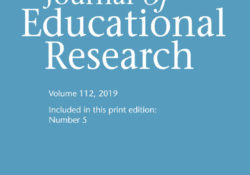tandfonline.com har udgivet en rapport under søgningen “Teacher Education Mathematics”: Abstract Abstract This study investigated upper secondary school students’ skills in evaluating the credibility and argumentative content of a blog text and a YouTube video. Both sources concerned child vaccination, the blog text opposing and the YouTube video supporting it. Students rated each source as credible, fairly credible or non-credible, justified their ratings, and analyzed the argumentation of both sources. Their justifications were analyzed for trustworthiness and expertise and their argument analyses for identification of the main position of the source and the reasons supporting it. Students’ justification skills proved fairly weak, and they also struggled with recognizing unbalanced argumentation. Students’ skill in analyzing the argumentation used in the sources also proved inadequate, especially in the blog text task. Overall… Continue Reading →
Like this:
Like Loading...
eric.ed.gov har udgivet: This study was designed to help faculty and administrators weigh the value of using student ratings of professors’ teaching effectiveness and to determine factors that may affect those ratings. For this study, conducted at a Midwestern AACSB accredited School of Business, 163 students (23% of the business majors) were surveyed to determine their perceptions concerning student ratings of faculty. Although 100% of the students surveyed believed they were honest in their evaluations, only 33% of them believed other students were honest. International students tended to give higher evaluations in math-related classes than U.S. students. Students tended to give higher evaluations to professors who used humor and to professors they liked. They did not give higher evaluations to male professors or ones under 55 years of age. The… Continue Reading →
Like this:
Like Loading...
eric.ed.gov har udgivet: In May of 2011, the “Los Angeles Times” published, for the second time, results of statistical studies examining the variation in teacher and school performance in the Los Angeles Unified School District, based on the California Standards Tests for math and English Language Arts (ELA). The studies use data from the seven academic years ending in 2009-2010. The “Times” published teachers’ names along with their effect estimates. These estimates were then used to classify teachers into five categories: least effective; less effective; average; more effective; and most effective. The “Los Angeles Times” previously published the results of statistical analyses designed to address the same issues in August, 2010, using data from the period 2003-2009. The earlier analyses were reviewed by Briggs and Domingue, who identified several serious… Continue Reading →
Like this:
Like Loading...
eric.ed.gov har udgivet: When presenting results from rigorous, field-based evaluations of educational interventions, researchers often reveal methodological barriers they face in designing studies to assessing program effectiveness. The evaluations funded by the Investing in Innovation Fund (i3) present a timely opportunity for identifying relevant and pressing issues arising in current education evaluations. With over $1 billion dollars invested in the implementation and evaluation of 117 education interventions, the i3 program represents a major investment by the U.S. Department of Education in educational interventions that will both serve students, teachers and schools, and generate evidence about intervention effectiveness. The breadth and number of i3 evaluations provides a unique opportunity to learn about the features of, and challenges encountered in, the design and implementation of the evaluations. Researchers from the National Evaluation… Continue Reading →
Like this:
Like Loading...
eric.ed.gov har udgivet: Teacher evaluation is at the center of current education policy reform. Most evaluation systems rely at least in part on principals’ assessments of teachers, and their discretionary judgments carry substantial weight. However, we know relatively little about what they value when determining evaluations and high stakes personnel decisions. The author leverages unique data from a public charter school district to explore the extent to which school administrators’ formative evaluations of teachers align with teacher and school effectiveness and predict future personnel decisions. While previous research has examined administrators’ subjective evaluations of teachers in surveys and in practice, this study links a detailed evaluation in practice with multiple types of personnel decisions to provide new insights into administrator decision-making. A better understanding of the teacher contributions that administrators… Continue Reading →
Like this:
Like Loading...
